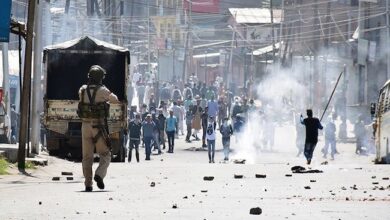IS’s media campaign shows it hasn’t given up on ‘Remains’ and ‘Expands’ narrative

By Asaf Day
In the past couple of months, the Islamic State (IS) has launched a media campaign labelled “And the [Best] outcome is for the righteous”. The campaign includes multiple videos of the jihadist organization’s affiliates from across the globe renewing their pledge of allegiance to the group’s leader Abu Bakr al-Baghdadi. Such affiliates include the Wilayas (provinces) of Khorasan, Qawqaz, East Asia, Sinai, West Africa, as well as most recently, Azerbaijan on July 2, southern Libya on July 8, Turkey on July 10, Tunisia on July 16, Somalia on July 16, Central Africa on July 24, Yemen on July 27, and Bingal (Bangladesh) on August 8.
The new campaign raises an obvious question, what’s the point? After all, the group constantly publishes the operations of these provinces and branches in its media (with the exception of the new and still inactive Azerbaijan). The campaign is linked directly to the group’s adjustments in the aftermath of the collapse of the self-declared physical “caliphate.” Aside from the group’s compelled shift in tactics, towards more insurgent-type warfare, the new campaign is part of its media and propaganda’s end to “cut losses” and project resilience, as well as even gains.
Since the caliphate’s establishment, al-Baghdadi’s organization has been using the slogan the State of Islam Remains and Expands or Dawlat al-Islam Baqiyah wa-Tatamadud. On the surface, the chant seems jocular in light of IS’s apparent dire conditions. That said, ironically, the group’s increasing dispersal of its affiliates, as part of its adaptation and transformation into a full-scale insurgent group, may actually enable the group to present an opposite picture. While for the average Western audience, the fall of the Islamic State and its turning into a guerilla group seems like a major setback and decline, for a radicalized Salafist individual, the new situation continues to fall in line with the “Remains and Expands” slogan. Thus, by depicting the videos of its affiliates, and particularly of new branches, al-Baghdadi’s organization projects not only steadfastness to its sympathizers and fighters but also an image of expansion.
The image of Remains is strengthened by videos showing the affiliates from Sinai, southern Libya, Turkey, Somalia, Yemen, Tunisia, West Africa, and East Asia, which at the same time are also highly successful on their fronts. The East Asia affiliate even takes it a step further and shows footages of the group’s fighting in addition to a large number of militants pledging fealty to al-Baghdadi. The effort to sustain this Remains narrative was recently highlighted by the video depicting the group’s leader in late April, showing that al-Baghdadi and his group are alive and well, and still functioning. During that video, al-Baghdadi was reviewing a magazine titled Wilayat Turkiya (Turkey Province), which suggests that the group had already known, and even planned, the creation of this new province. By extension, the Turkey case further indicates that IS was prepared as early as April to launch this campaign, as well as the formation of the new affiliates. More specifically for Turkey, the new video likely aims at reviving the organization’s activity in the country after a noticeable lull in operations over the past two years.
The new video of the individuals pledging fealty in Azerbaijan clearly feeds into the Expands narrative, despite the lack of a confirmed attack by the group in the country, which makes the video highly notable. That said, it is noteworthy that in this video, there are only three individuals with an improvised set at the background, namely a sheet meant to cover their whereabouts, which make it seems a bit crude to the viewer. Moreover, while the persistent operations and published images by Khorasan, Central Africa, and Qawqaz groups fall in line with the Remains narrative, as they are known to be active for some time in their respective regions, they also likely advance the Expands perception. Wilayat Qawqaz, for example, although somewhat active in Russia over the past several years, is a less known affiliate in comparison to other affiliates, thus may appear to some like a new branch. This is similarly the case with regards to Wilayat Bingal. Moreover, while the Central African branch is quite active in the past several, it is still rather new so it could still be included within the Expanding category. As for the province of Khorasan, while the group is highly active for some time, its video, in addition to showing scenes from the battlefield, is noticeably the longest and present multiple groups of fighters from different regions within the “jurisdiction” of Khorasan, such Kashmir, Iran, India (Hind), West Afghanistan, and Pakistan. The groups from India, Kashmir, and Pakistan are particularly notable as IS recently acknowledged them as new Wilayas, a fact which strengthens the speculations that they are just operatives from Khorasan and does not mean that they bolstered their operational capabilities in these areas. Therefore, the depiction of the plurality of cells throughout Khorasan indeed portrays an image of expansion.To sum things up, despite our understandable reflex of assuming that IS gave up on the narrative of “expansion”, the latest videos dubbed “And the [Best] outcome is for the righteous” illustrate that the jihadist organization did not abandon this long-standing slogan. Thus, it is expected that the group will publish new videos of that series, potentially from Algeria, mainland Egypt, and the Palestinian Territories, and even other new regions, similarly to the Azeri one.
Asaf Day is a Middle East and North Africa geopolitical analyst at a private security-consultancy firm. His areas of expertise include Syria, Israel, and the Palestinians, as well as global jihad organizations. Asaf holds an MA Degree in Arabic Studies from the University of Bar Ilan and a BA from Ben Gurion University, both in Israel. In addition to English, Asaf speaks fluent Hebrew and Arabic, as well as Turkish and French to a lesser degree.




